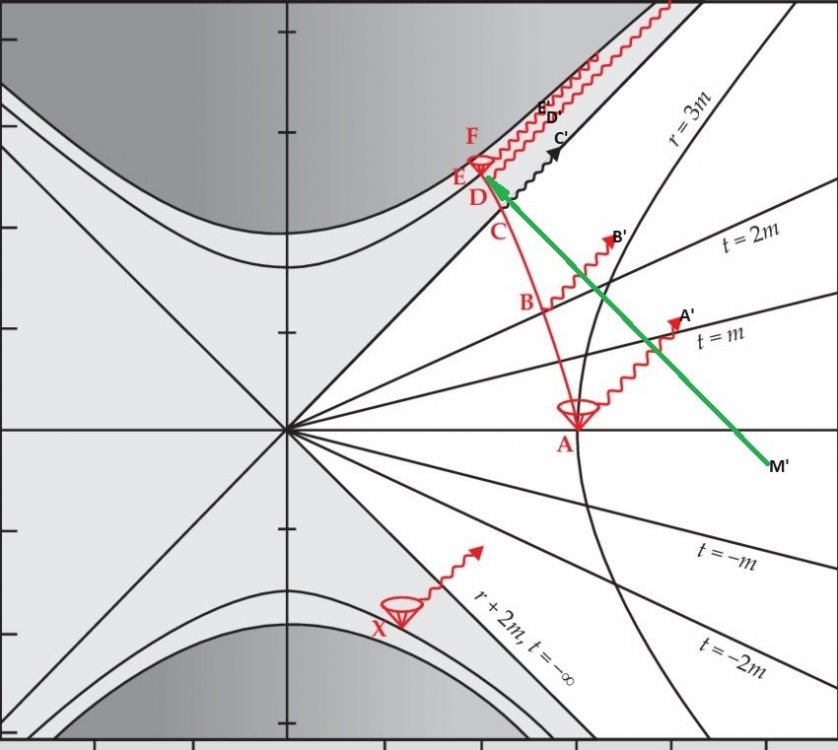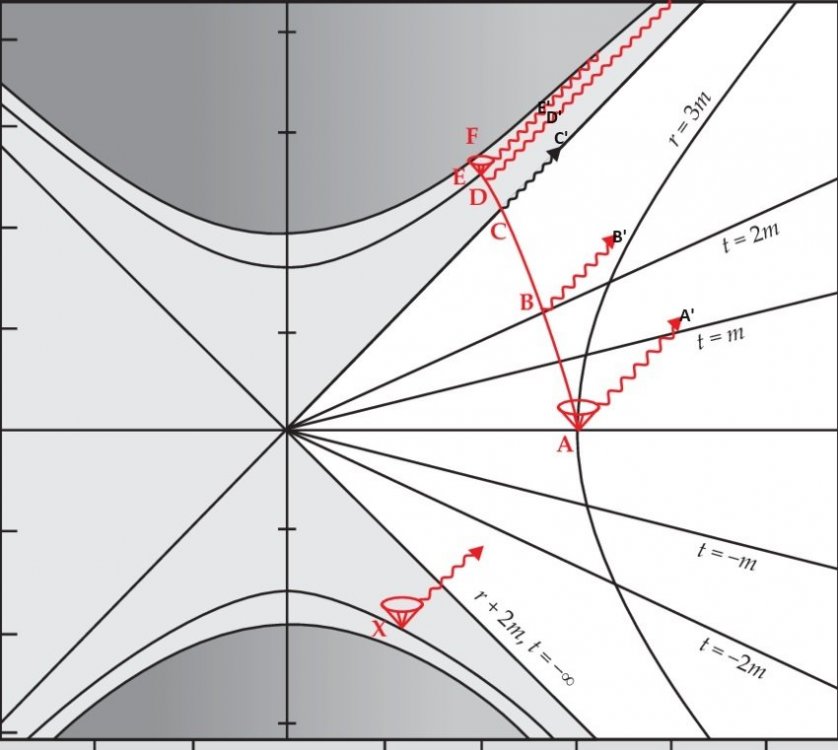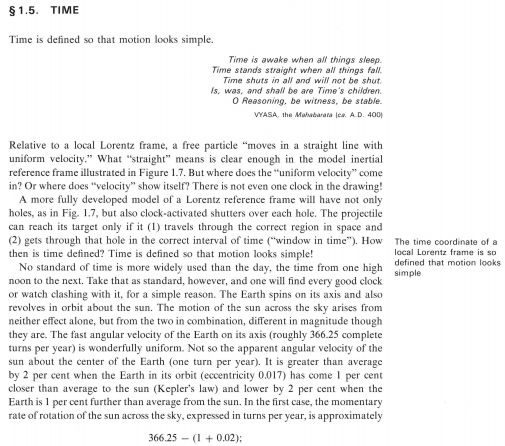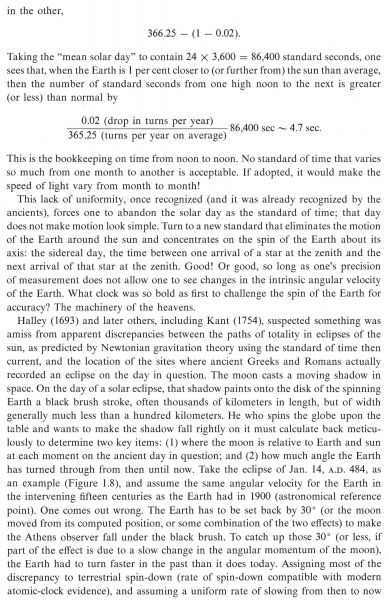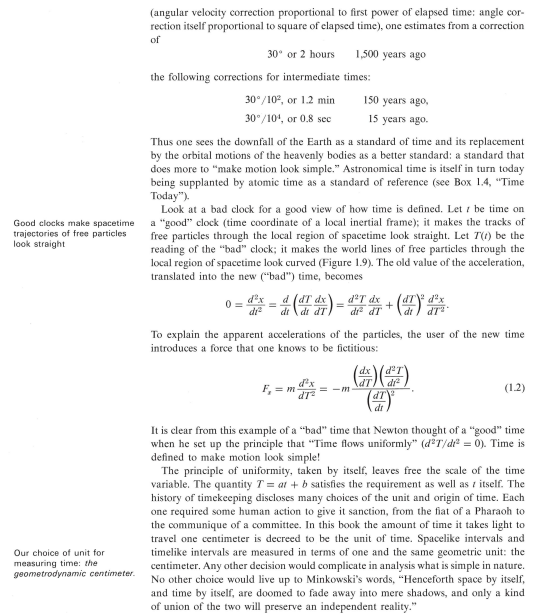-
Posts
5373 -
Joined
-
Days Won
52
Content Type
Profiles
Forums
Events
Everything posted by Genady
-
The 45o line that goes through the origin and the events C and C', is a worldline of EH. The greyish area above it and to the left, with the events D, E, D', E', is inside the BH. The white area to the right and below - outside the BH. The hyperbola separating the light grey and the dark grey, with event F on it - singularity.
-
Here the green arrow shows that the unprimed observer being at event D sees the primed observer being at event M' (approximately):
-
This will help. As Susskind says in the General Relativity: The Theoretical Minimum, This is the figure 5, for reference:
-
All photons behind the horizon, in this diagram, go toward the singularity. There are no "backward-sent photons" there. Incorrect. Use the Kruskal diagram to find who sees whom and how.
-
The primed observer, falling through the horizon at event C', sees the unprimed observer, which is falling through the horizon at event C.
-
The same. As long as the falling objects are much smaller than the BH.
-

Space Exploration Within Our Solar System
Genady replied to Chris Sawatsky's topic in Astronomy and Cosmology
Do you have any discussion points pertaining to Astronomy and Cosmology? -
Does time exist? Yes, it does.
-

Why is it so hard to explain time? (What is time?)
Genady replied to chron44's topic in Classical Physics
The formula above is correct only for a flat spacetime in Minkowski coordinates. The general GR formula is, $$ds^2=g_{\mu \nu} dx^{\mu} dx^{\nu}$$ (the summation convention implied.) In GR, this "crucial parameter" does not appear in any important formulas. There is no such thing. It is either one event or separate events. Nowhere in GR time is treated as the 4th spatial dimension. -

Thinking about hyperbolic planes and the field of physics
Genady replied to SillyLilGuy's topic in Classical Physics
What does make you think about hyperbolic planes? What do you mean by "the field of physics"? -

Thinking about hyperbolic planes and the field of physics
Genady replied to SillyLilGuy's topic in Classical Physics
What physics do you know? And, as mathematics is the language of physics, what mathematics do you know? Relating to your post, what do you know about hyperbolic planes, fields in physics, forces, electromagnetic field, Euclidean plane? -

Why is it so hard to explain time? (What is time?)
Genady replied to chron44's topic in Classical Physics
Neither. It is just nonsense. -

Proportion of the area covered by circles
Genady replied to Dhamnekar Win,odd's topic in Applied Mathematics
No, this is not so. Here it is: -

Why is it so hard to explain time? (What is time?)
Genady replied to chron44's topic in Classical Physics
Not answering is not enough. I use filters provided by the site's software to avoid seeing such bs on my screen. The site's organization provides clear separation of different forums. By violating this separation, you piss in my yard. -

Why is it so hard to explain time? (What is time?)
Genady replied to chron44's topic in Classical Physics
This is what defines if it belongs to this forum. So, your stuff can be "research" somewhere else, but it is spam here. -

Why is it so hard to explain time? (What is time?)
Genady replied to chron44's topic in Classical Physics
Science does not consider it a legitimate reference. Your "quest" is not a science, your "reference" is not a scientific reference. Take your thread and go elsewhere. Stop spamming the science forum. -

Why is it so hard to explain time? (What is time?)
Genady replied to chron44's topic in Classical Physics
Do you have a reference to this? -

Proportion of the area covered by circles
Genady replied to Dhamnekar Win,odd's topic in Applied Mathematics
Look at the picture for case 2: You can count, \(n=13\). You can measure, \(R/r_n \approx 5\). If your formula, \(P_n = \displaystyle\frac{n \cdot r_n}{2\cdot R -r_n}\) were correct, then \(P_{13}=\displaystyle\frac{13 \cdot 1}{2\cdot 5 -1} \gt 1\), which cannot be correct because it has to be \(\lt 1\) for any \(n\). So, your result is wrong. -

Proportion of the area covered by circles
Genady replied to Dhamnekar Win,odd's topic in Applied Mathematics
Please show it. -

Proportion of the area covered by circles
Genady replied to Dhamnekar Win,odd's topic in Applied Mathematics
Surely your result, \(P_n=2.0944\) is wrong because \(P_n\) has to be \(\lt 1\) by its definition. -

Proportion of the area covered by circles
Genady replied to Dhamnekar Win,odd's topic in Applied Mathematics
I'd need to see your step-by-step derivation. -

Why is it so hard to explain time? (What is time?)
Genady replied to chron44's topic in Classical Physics
Here is the explanation of how time is defined, from the Gravitation by Misner, Thorne, and Wheeler:


